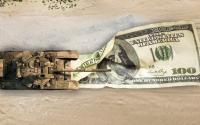2 July 2007Adam Nossiter
Northern Alabama has become acre after acre of shriveled cornstalks, cracked red dirt for miles and days of unrelenting white heat. The region’s most severe drought in over a century has farmers here averting their gaze from a future that looks as bleak as their fields.
The drought is worst here, but it is wilting much of the Southeast, causing watering restrictions and curtailed crops in Georgia, premature cattle sales in Mississippi and Tennessee, and rivers so low that power companies in the region are scrambling and barges are unable to navigate. Fourth of July fireworks are out of the question in many tinderbox areas. Hay to feed livestock is in increasingly short supply, watermelons are coming in small and some places have not had good rain since the start of the year.
On Monday, Dennis Bragg, the biggest farmer in Madison County, the drought’s center, clutched a scrawny, leathery cornstalk half as high as it should be, barely reaching his waist. A healthy one should now be towering over him, according to the calendar.
“This right here is going to be a zero,” Mr. Bragg said, pushing the puny thing away. “This is what we call a weed.” The field of muted green will be a loss.
Down the road, he stopped his truck at a barren hillside that should be carpeted with green soy plants. “I tend not come over here and look at it,” he said, bending his head. “This whole hill never came up because of the drought.”
In the browning corn fields here, the light breeze makes a tindery noise as it rustles the dry stalks.
Struggling to pay their bills, farmers here in the Tennessee Valley say they are burning through cash reserves and staring at bankruptcy, as last year’s dry weather turned into a singeing drought this year. Gleaming steel grain bins that should be full of corn ready to become ethanol are virtually empty. Cattle sales are several times normal; the farmers have nothing to feed them. Harvest day’s expected small returns will be make-or-break time, farmers here say.
Meanwhile, elsewhere in Alabama, beetles are boring into bone-dry pine trees, threatening century-old stands. Lake levels are 10 feet below normal, and boathouses are sticking up out of the water.
There is also a drought in Southern California and much of the Southwest, but the one in the Southeast, encompassing more than a dozen farm-reliant states as far north as Ohio and Indiana, is more unusual, producing conditions not seen in more than 50 years in some places, and longer in northern Alabama.
Much of the region, government scientists say, is suffering from a rare sharp dry spell, though they are reluctant to attribute it to climate change. “In terms of its intensity, this one is very severe,” said Donald Wilhite, director of the National Drought Mitigation Center at the University of Nebraska, Lincoln.
Most of northern Alabama, along with parts of Mississippi and Georgia, is rated D4, the center’s highest possible level of drought intensity, signifying an exceptional drought.
Scientists call it a cruel freak of nature, one that is causing misery to farmers at a critical period in the growing cycle and has already ruined a “startling” proportion of Alabama’s agricultural output, said Douglas Le Comte, a senior meteorologist at the National Oceanic and Atmospheric Administration. Some 88 percent of the state’s corn crop is classified by the government as poor to very poor, along with 85 percent of its soybeans and 74 percent of its cotton.
“The reality is, we’re going to lose a significant amount of money this year,” said Stuart Sanderson, a fourth-generation farmer in Limestone County, east of here. The foothills of the Appalachians make an alluring backdrop, but the reality on the ground is grim.
“A disaster like this is one you never see coming. We’re looking at a 70 to 80 percent loss,” Mr. Sanderson said, standing by a useless field of shrunken cornstalks. The rare, stunted ear could only manage a few malformed grains.
Deep cracks in the red earth indicated dry soil inches deep. “I’ve never seen this ground do that,” he said.
Rainfall is at least 20 inches below the normal 32 inches and in some places far lower than that. Jerry Newby, president of the Alabama Farmers Federation, said: “It’s gone from bad to worse. All of the corn is pretty much lost that’s not under irrigation.”
On Monday, the entire state was declared a drought disaster area by the federal Department of Agriculture, making many farmers eligible for low-interest emergency loans. “Nobody alive has ever seen it like this,” said Perry Mobley, the beef and hay director of the farmers’ federation. And the National Weather Service says conditions are unlikely to change until fall.
The governors of Georgia and Alabama called for prayer; rare showers in the following days made the front pages here earlier this week.
Out at Mr. Bragg’s 7,000-acre, third-generation spread just north of Huntsville, immediate worries are pressing: he is facing the classic farmer’s debt squeeze, with heavy investment — $1 million in giant new silos, a down payment on an ethanol-based future — and little revenue to pay for it. Mr. Bragg is contemplating a $500,000 loss.
Mr. Sanderson’s grain bins cost $400,000. “Not only have we lost our revenue, I’m also $400,000 in debt,” he said.
Mr. Bragg said, “My salary is tied to how much it rains.” He is luckier than most because some of his crop is irrigated by giant sprayers. He still has “the potential to work for this whole year and not get paid.”
In his cotton fields, the stalks are not high enough to be reached by the mechanical picker. Every stalk should have 10 bolls, but these barely have four or five.
The drought takes a psychological toll. Mr. Bragg spoke of a tight feeling in the pit of his stomach when drought sets in. “Mentally, we expect it,” he said, “but genetically, we can’t handle it.”
The true reckoning will be unpleasant , and it will come later this year. “I don’t plan on having to sell out this year,” Mr. Sanderson said. “But there’s only so much I can handle. If we come out next year with another year like this, you’re going to see a significant number of farmers go out of business.”






